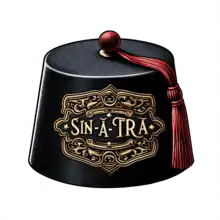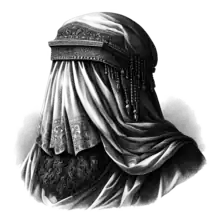Mystic Order of Veiled Prophets of the Enchanted Realm
The Mystic Order of Veiled Prophets of the Enchanted Realm, also known as M.O.V.P.E.R. or The Grotto, after its lodge equivalent, is an appendant body in Freemasonry.[1]

| Part of a series on |
| Freemasonry |
|---|
 |
| Part of a series on |
| Esotericism |
|---|
 |
Overview
It is a social organization for Master Masons, and as such, all Master Masons are welcome to join. [2] It encourages renewed interest in the Blue Lodges and the study of its deeper teachings in a social and relaxed atmosphere,[3] though it makes no claim to be a part of Symbolic Craft Masonry. [4]
Members are distinguished by a black fez with a red tassel and sometime with a Mokanna head in the middle.[5] A Monarch (President of a single grotto), wears a black Fez with a purple tassel and a Grand Monarch (President of the Order) wears a black Fez with a Yellow tassel, all other Grand Officers wear a black Fez with a white tassel.[6][7]
History
The Mystic Order of Veiled Prophets of the Enchanted Realm, also known as M.O.V.P.E.R. or The Grotto, was founded in the summer of 1889 by LeRoy Fairchild and other members of Hamilton Lodge #120 in Hamilton, New York.[8] They organized quality gentlemen meetings for discussing blue Lodge deeper meaning with fun and good fellowship.[9] At their meeting on September 10, 1889, they decided to call the group the “Fairchild Deviltry Committee” and restrict membership to Master Masons in good standing. The idea of the Order proved to be attractive, and many Masons joined.[8] In response to requests, other groups were formed in other areas, and on June 13, 1890 the former “Fairchild Deviltry Committee” duly established and formed the Supreme Council, Mystic Order of Veiled Prophets of the Enchanted Realm.[8] Its purpose was officially "to add in greater measure to the Masonic fraternal spirit the charm of radiant cheerfulness and to maintain within the fraternity an impetus of royal good fellowship and study the Blue Lodge degrees". It is a social organization for Master Masons, and as such, all Master Masons are welcome to join. It encourages renewed interest in the Blue Lodges, though it makes no claim to be a part of Symbolic Craft Masonry.[2][10]
For a few years the Mystic Order of Veiled Prophets of the Enchanted Realm had no official emblem to wear. Word got around that the Mystic Order of Veiled Prophets were permitted to wear an emblem that set them apart from others and a black Fez head covering was selected with a Mokanna Head in the center, giving the name of the Grotto.[8]
From 1902 on, the Supreme Council would elect and transition power to officers on a yearly basis.
The minutes of a February 26, 1903 stated meeting of Azim Grotto, Bronx, New York states: “Prophet Charles E. Lansing, Past Potent Monarch, after some preliminary remarks, descriptive thereto, presented to those present, a drawing in color of a headgear appropriate for the Order. The same was received with favor and by motion, regularly made and seconded and carried, it was unanimously decided to adopt and wear them on serious and other appropriate occasions.” [11][4][12]

In the minutes of October 29, 1903, it is recorded: “The Potent Monarch reported that the Fez worn by our members was, at the Annual Session of the Supreme Council help at Hamilton, New York on October 20, adopted as the official headgear for all Prophets of the Realm.”[13]
The Chelminar Grotto, situated in Yakima, Washington, was established in 1921 and continues to be operational to this day. On the other hand, the Zafar Grotto, located in Williamsport, Pennsylvania, stands as one of the largest Grottoes in the nation, boasting a membership of over 350 individuals. While many Grottoes intentionally maintain a smaller membership to foster a sense of close-knit fellowship, this selective approach occasionally draws criticism for perceived elitism from other Masons.[14][2]
The Veiled Prophet

The logo of the Grotto, M.O.V.P.E.R., is distinguished by a Mokanna head, giving the name of the Grotto. This emblem sets members of the Mystic Order of Veiled Prophets apart from others.[10][15]
Exploration of the historical narrative surrounding the Grotto organization necessitates a comprehensive understanding of its emblematic figure, Mokanna, and the origins of this intriguing tale. To embark on this journey of knowledge, one must transport themselves to the distant past, specifically to the year 779 AD, where we find the enigmatic figure known as Al-Muqanna, whose epithet translates from Arabic as "the Veiled One." Though he commenced his earthly existence as a humble clothes pleater, Al-Muqanna's life took a momentous turn when he espoused the radical teachings of Abu Muslim of Khorasan. Following Abu Muslim's tragic demise, Al-Muqanna, in an audacious move, established a religious sect premised on the notion that Abu was a reincarnation of the Divine, and upon his passing, this divine mantle was passed on to Muqanna. Such beliefs were nothing short of radical, earning Al-Muqanna the antipathy of more conventional religious adherents.[16]
It is intriguing to note that Al-Muqanna was reputed to habitually veil his visage, ostensibly to conceal the splendor and magnificence of his countenance from his fervent disciples. However, a different narrative emerges from the accounts of locals, who, unenthusiastic about his unconventional interpretation of Islam, contended that the veil was merely a ruse to obscure the fact that he was bald and had lost an eye. In due course, Al-Muqanna and his followers mounted a rebellion, but their rebellion was ephemeral, as the authorities orchestrated his immolation within the confines of his residence. A fate most gruesome, one might add.[17]
The story, however, did not conclude with Al-Muqanna's fiery demise. Fast forward a millennium, and one encounters the distinguished Sir Thomas Moore, who penned a romance titled "Lalla Rookh." This novella unveils a captivating narrative featuring a resplendent Princess, the eponymous Lalla Rookh. She embarks on a journey to wed a distant prince she has never met and, understandably, carries with her a certain trepidation. Yet, her apprehension finds respite in the presence of a minstrel and raconteur accompanying her entourage. Entranced by his mesmerizing tales, one of which is the enthralling "Veiled Prophet of Khorasan," she eventually discovers that this storyteller is none other than her betrothed prince in disguise. Their union heralds a happily-ever-after, a familiar trope in romantic tales.[18]
The contemporary ritual of the Grotto organization loosely draws inspiration from Moore's narrative, adorned with distinct Masonic embellishments along the way. It is imperative to acknowledge that each Grotto branch may impart its unique interpretation of the story. Thus, the opportunity to witness a Grotto initiation should not be missed, for it is an occasion to partake in a captivating narrative that melds history, mystique, and fraternal traditions into a tapestry of symbolic significance and cultural resonance.[19][20]
Philosophy
The Mystic Order of Veiled Prophets of the Enchanted Realm, also known as the Grotto, is guided by a philosophy that goes beyond simple enjoyment and celebration. This philosophy is deeply rooted in the concept of Good Fellowship, a principle that mirrors the essence of the Golden Rule.
Good Fellowship is more than just mutual respect and reciprocity; it represents a spirit of camaraderie, unity, and shared joy. This philosophy encourages spiritual growth, a renewed love for life and laughter, and a strengthened sense of optimism. It transforms ordinary experiences into moments of joy and fulfillment.
While The Grotto is often seen as a journey filled with joy, fun, and frolic, the Grotto recognizes a solemn and serious motif beneath this surface of gaiety. This motif is not an abstract concept but a tangible philosophy that shapes our actions and perceptions.
As members of the Grotto, individuals are encouraged to adopt this philosophy. It serves as a guiding light in their journey, leading them to find joy in shared experiences, treat others with kindness and respect, and embrace life with laughter and optimism. Amidst the complexities of life, this philosophy serves as a reminder of a simple yet profound truth: Life is not just about fun and frolic; it’s about learning, growing, and fostering Good Fellowship.[21]
Female auxiliaries
History
The Daughters of Mokanna is a fraternal organization for ladies founded in 1919.[22] The purpose of the Order is to support Grottoes International in their efforts, and to provide fun, fellowship, comfort, and aid to one another1. They are proud to support the Grotto’s Humanitarian Foundation, which provides dental care for special needs children.[6]
The Daughters of Mokanna was born on June 5, 1919. The four original subordinate Daughters of Mokanna that opened in their respective communities were #1 – Amoo - Rock Island, IL; #2 – Mohassan - Davenport, IA; #3 – Ankara - Kansas City, MO; and #4 – Zal - Moline, IL2. Together, these four subordinate chapters formed the Supreme Daughters of Mokanna.[23]
The aim of the Daughters of Mokanna is to bring into closer relationship the families of Grotto members and to promote Sociability, Friendship, Charity, Education and Patriotism. Their major humanitarian work is supporting the Enchanted Lantern program through the Supreme Council M.O.V.P.E.R. Humanitarian Foundation.[23]
Requirements
The Daughters of Mokanna is easier to get in than the M.O.W.O.S. To be eligible for membership, candidates must be either or:
- The wife, widow or adult female relative of a Veiled Prophet (Grotto member can also be invited).
- Related to a Master Mason in good standing.
- Be a member in good standing in an organization recognized by the Masonic Lodge (i.e., Eastern Star, Amaranth, etc.).
Creation of new caldrons
According to their regulations, only a single Caldron can be established within a city limit, with its jurisdiction aligning with that of the corresponding Grotto. The initiation of a new Caldron requires a petition for dispensation, which must be endorsed by a minimum of 25 women. These women must be at least 18 years old and have a familial connection to a Veiled Prophet of the Enchanted Realm.
Once established, a Caldron operates autonomously, managing its own affairs and finances. It has the authority to draft its own Bylaws and governs itself in compliance with the constitution of the Supreme Caldron.
Attire
Different fezzes are worn to signify various ranks or roles within the organization:
- The Regulation Fez is blue, adorned with red tassel and lettering. This is the standard fez worn by members of the order.
- The Mighty Chosen One, a distinguished position within the order, wears a red fez with a gold tassel to signify their status.
- A Past Mighty Chosen One, someone who has previously held the position of the Mighty Chosen One, wears a white fez. This fez is distinguished by a purple tassel and lettering.
These different fezzes serve as visual indicators of the roles and experiences of the members within the organization.
Requirements
This group is on invitation only, to be invited, one must be:
- The wife, partner, widow, or female relative (daughter, sister, ...) or a female friend of a member of a Veiled Prophet (Grotto member can also be invited).
- Be invited by an existing witch (member) or be part of the formation a new cauldron by Grotto Members.
- Be over the age of 21 years old.
- Be a good and moral character.
- Have not asked to be invited.
Purpose
The M.O.W.O.S. was founded during a time of great social and cultural change in the United States. The early 20th century was a time of rapid industrialization and urbanization, and many people were feeling displaced and uncertain about the future. In this context, the M.O.W.O.S. offered a sense of community and belonging for its members. The group's name is a reference to the Salem witch trials, which took place in Massachusetts in 1692. During the witch trials, hundreds of people were accused of witchcraft and executed. The M.O.W.O.S. reclaims the image of the witch, transforming it into a symbol of female empowerment and strong sisterhood.
History
Sometime prior to 1917, the Mysterious Order Witches of Salem was founded as a female auxiliary to the Grotto. The first “Caldron,” the term used for a local chapter of the Mysterious Order Witches of Salem was founded in Chicago, IL, and was known as Aryan Caldron No. 1.[24]
On January 15, 1918, Amoo Caldron No. 2 was constituted in Rock Island, IL. In 1918, the Supreme Caldron was formed, consisting of Aryan No. 1 and Amoo No. 2, with officers coming from both groups. Later, Koom Caldron No. 3 was opened in Rockford, IL.[25]
On or about Wednesday, March 5, 1919, Amoo Caldron No. 2 seceded from the “Supreme Caldron,” which was mostly being operated out of Chicago. The ladies in Rock Island promptly declared themselves the new Supreme Caldron and Amoo Caldron became No. 1. On November 18, 1920, Mrs. Vashti H. Bollman, acting Supreme Enchantress of the "new" Supreme Caldron notes that Mrs. Josephine Mace, Mysterious Enchantress of Amoo No. 2, withdrew Amoo from the parent organization in Chicago. It is reported that she was brought up on fraternal charges, to which she pled guilty, surrendering the charter of Amoo No. 2 in the process. However, she refused to give up the name “Amoo Caldron” and used it to “usurp the name Supreme Caldron from the parent organization.” [26] The Amoo group began opening new Caldrons, getting up to at least five with the institution of Hapac Caldron No. 5 in 1920.[27]
According to the history published by Omala Caldron on its website,[28] the Daughters of Mokanna formed in 1919, in Rock Island, Illinois. This coincides with the secession of Amoo from Chicago and the founding of their own Supreme Caldron. They go one to describe how the ritual was decided upon and list the first four Daughters of Mokanna Caldrons – Amoo No. 1, Mohassan No. 2, Ankara, No. 3, and Zal No. 4. This would lead one to believe that Hapac was No. 5 as listed in the newspaper accounts. However, no account is given as to what happened to Koom Caldron No. 3, except that it shows up as participating in the Daughters of Mokanna national Convention in 1922.[29]
Like its male counterpart, the group is involved in fun and fellowship, as well as charitable activities directed toward cerebral palsy and dentistry for the handicapped. The current number of Witches (members) is unknown as the group is very discreet.
The MOWOS is also known for its elaborate costumes and rituals, but because of a careful and grand secrecy the rituals are safely guarded and no written copies are made available online or on paper.[30]
References
- Alan Axelrod International Encyclopedia of Secret Societies and Fraternal Orders New York; Facts on File, inc 1997 p.110
- "The Grotto".
- Book: History and Directory of Keder Khan Grotto, No. 12, M.O.V.P.E.R., Syracuse, New York. Author: Charles L. Wright (Secretary.)
- "HISTORY OF THE GROTTOES OF NORTH AMERICA, M.O.V.P.E.R."
- "SOME OF THE MANY PRIVILEGES OF BEING A GROTTO MEMBER".
- "What is the Grotto?". Sahara Grotto MOVPER.
- "Grand Line Officers & Staff | Grottoes Intl". scgrotto.org.
- "Grotto and Related". The Museum of Fezology. August 1, 2011.
- "What is the M.O.V.P.E.R.? – Ormazd Grotto". www.ormazdgrotto.org.
- "The official site of Grottoes International". scgrotto.org.
- Axelrod p.110
- "Frequently Asked Questions".
- Hutchinson, Kenneth (December 2011). History of the Grottoes of North America, MOVPER. The Grottoes of North America. The Grottoes of North America.
- "Grotto History, M.O.V.P.E.R. – OHIO GROTTO".
- "Feramo Grotto M.O.V.P.E.R." Feramo Grotto.
- "The Veiled Prophet Mokanna and Zelica, from the Tale of Lalla Rookh, by Thomas Moore". philamuseum.org.
- "Just who was Mokanna?". October 1, 2011.
- "The Story of the Veiled Prophet · The tales and travels of Lalla Rookh · Digital Exhibitions at Special Collections & Archives, Queen's University Belfast". omeka.qub.ac.uk.
- "A Drama, in Three Acts, entitled Mokanna; or, the Veiled Prophet of Khorassan. With chorusses and song. by COOPER, William.: (1843) | Jarndyce, The 19th Century Booksellers". www.abebooks.com.
- Book: A Drama, in Three Acts, entitled Mokanna; or, the Veiled Prophet of Khorassan. With chorusses and song. COOPER, William.
- "Who, What, When, Why". www.mastermason.com.
- Mokanna, Daughters of. "Daughters of Mokanna". Daughters of Mokanna.
- Mokanna, Daughters of. "Daughters of Mokanna". Daughters of Mokanna.
- Rock Island Argus., March 06, 1919, http://chroniclingamerica.loc.gov/lccn/sn92053934/1919-03-06/ed-1/seq-10/#date1=1789&index=2&rows=20&words=Mysterious+Order+Salem+Witches&searchType=basic&sequence=0&state=&date2=1924&proxtext=mysterious+order+witches+of+salem&y=0&x=0&dateFilterType=yearRange&page=1
- Rock Island Argus., April 03, 1919, http://chroniclingamerica.loc.gov/lccn/sn92053934/1919-04-03/ed-1/seq-5/#date1=1789&index=1&rows=20&words=caldron+CALDRON+Koom&searchType=basic&sequence=0&state=&date2=1924&proxtext=koom+caldron&y=0&x=0&dateFilterType=yearRange&page=1
- The Rock Island Argus and daily union., November 18, 1920, http://chroniclingamerica.loc.gov/lccn/sn92053933/1920-11-18/ed-1/seq-2/#date1=1789&index=1&rows=20&words=Mysterious+Order+Salem+Witches&searchType=basic&sequence=0&state=&date2=1924&proxtext=mysterious+order+witches+of+salem&y=0&x=0&dateFilterType=yearRange&page=1
- The Rock Island Argus and daily union., October 12, 1920, http://chroniclingamerica.loc.gov/lccn/sn92053933/1920-10-12/ed-1/seq-8/#date1=1789&index=0&rows=20&words=Mysterious+Order+Salem+Witches&searchType=basic&sequence=0&state=&date2=1924&proxtext=mysterious+order+witches+of+salem&y=0&x=0&dateFilterType=yearRange&page=1
- "Untitled Document". Archived from the original on 2018-06-09. Retrieved 2016-12-15.
- The Rock Island Argus and daily union., June 26, 1922, http://chroniclingamerica.loc.gov/lccn/sn92053933/1922-06-26/ed-1/seq-23/#date1=1789&index=4&rows=20&words=orders+Salem+Witches&searchType=basic&sequence=0&state=&date2=1924&proxtext=order+witches+of+salem&y=0&x=0&dateFilterType=yearRange&page=1
- Bungert, Heike; Heitmann, Jan G.; Wala, Michael, eds. (2003-05-01). Secret Intelligence in the Twentieth Century. doi:10.4324/9780203498859.